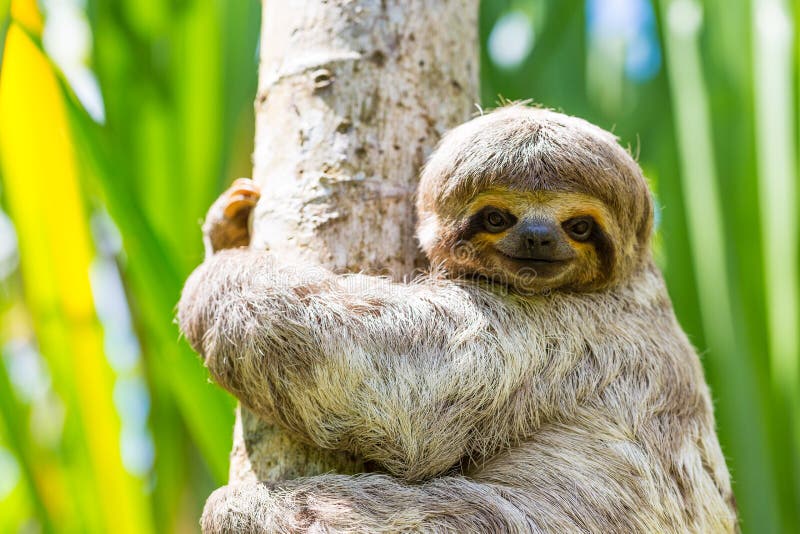- Sloths are also shockingly strong, even though their muscle mass is 30 percent less than that of similarly sized animals. That's because their muscles are composed of slow-twitch fibers that.
- Sloths don’t have the best vision. In fact, they’re blind in bright daylight. Sloths may be slow on land but they are super-quick in the water. It takes nearly 30 days for a sloth to digest one leaf.
Animals arboreal exploration extinct fossils history leaves nature plants seed dispersal sloth slow TED Ed trees Around 35 million years ago, Earth was populated with giant, prehistoric ground sloths like Megalonyx jeffersonii (named after Thomas Jefferson ), Paramylodon, and Megatherium who, until around 10,000 years ago, roamed what would. That may sound slow, but it's some of the fastest scientists have seen in mammals. For growth that speedy, these giant sloths must have had a strong advantage over their smaller relatives.
The new European data protection law requires us to inform you of the following before you use our website:
We use cookies and other technologies to customize your experience, perform analytics and deliver personalized advertising on our sites, apps and newsletters and across the Internet based on your interests. By clicking “I agree” below, you consent to the use by us and our third-party partners of cookies and data gathered from your use of our platforms. See our Privacy Policy and Third Party Partners to learn more about the use of data and your rights. You also agree to our Terms of Service.
A sloth is an arboreal mammal famous for its slow movement and spending most of its time sleeping while hanging upside down on a tree. There are six species of sloths, broadly divided into two families; three-toed and two-toed sloths. Although sloths have three toes on each of the rear limbs, it is the front limbs that cause the difference in the two families. These species are mainly found in the tropical rainforests of Central and South America. The animal is named so (sloth) because of the slow rate of metabolism and the deliberate slow movement. Sloths move faster in water than on land where they are almost helpless.

Slow Sloth Video
Physical Characteristics
Sloths vary in size and weight. An adult species can be as long as 24-31 inches and weigh 7.9-17 pounds. Two-toed species are slightly larger than the three-toed species. The limbs of sloth are longer and the heads are bigger with tiny ears. The tail is about 2.4 inches long. Sloths are unique mammals in that they do not have seven cervical vertebrae. Three-toed sloth has 8-9 while two-toed has 5-7 cervical vertebrae. Sloths have poor hearing and visual acuity. Thus, they mainly rely on the senses of touch and smell to locate their food. The hair of the sloth fur grows away from the extremities because they spend most of their time with their limbs above the body. Their shaggy coat host other species including parasitic arthropods and algae.
The Slow Movement
Evolution
Why Are Sloths Slow
Sloths are considered the slowest mammals on earth. They do everything, including blinking, in slow motion with no need to rush. Sloths spend most of their time on trees, only coming to the ground if they want to move into the water or defecate. On average, a sloth can travel 40 yards in a day. The slow movement in sloths is attributed to their evolution and how they presently survive. The modern-day sloth is a smaller version of the sloths that lived in the prehistoric world. The ancient sloths were giants and weighed several tons. They walked on the ground and foraged from trees while standing up on their hind legs. However, after years of evolution, the sloths became smaller and could not reach the leaves while standing. They had to climb up a tree where they presently spend most of their time.
Diet
Both going up the tree and the diet that is entirely based on leaves have majorly contributed to the slow movement of sloths. Leaves are poor in nutrients and it also takes a lot of time for calories to be derived from them. Because of the two factors, sloths have a slow rate of metabolism to help them cope with the low caloric intake. To also ensure that they preserve energy, sloths move at a sluggish pace through the trees. To keep the body energized all the time, mammals need to eat a lot. However, sloths spend up to 15 hours sleeping and the remaining 9 hours lumbering through the trees. Sloths inhabit the tropical forests where the climate is hot and humid. Because the environment is already warm, sloths do not need to expend a lot of energy to keep their systems warm.
Sloths are the slowest mammals on earth. They spend most of their time on trees sleeping and only come to the ground to defecate or move to the water. Their slow movement is associated with a slow rate of metabolism. Their diet of leaves is what is to blame for slow metabolism.

